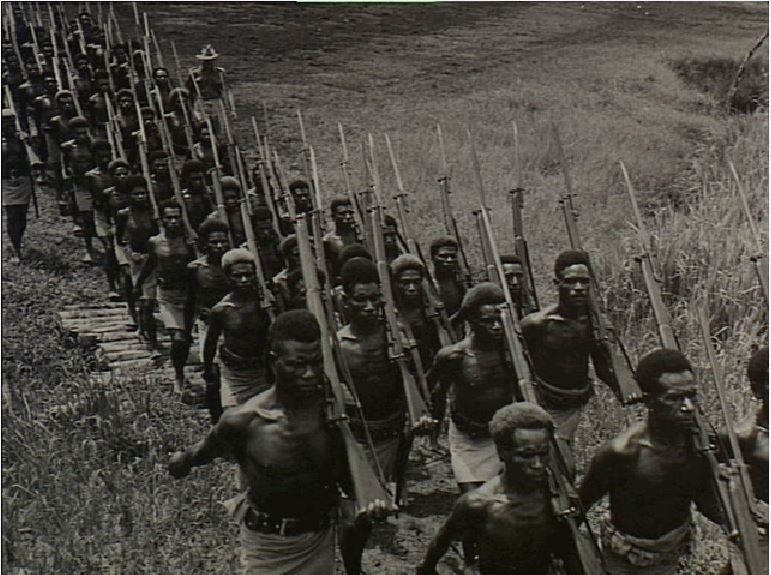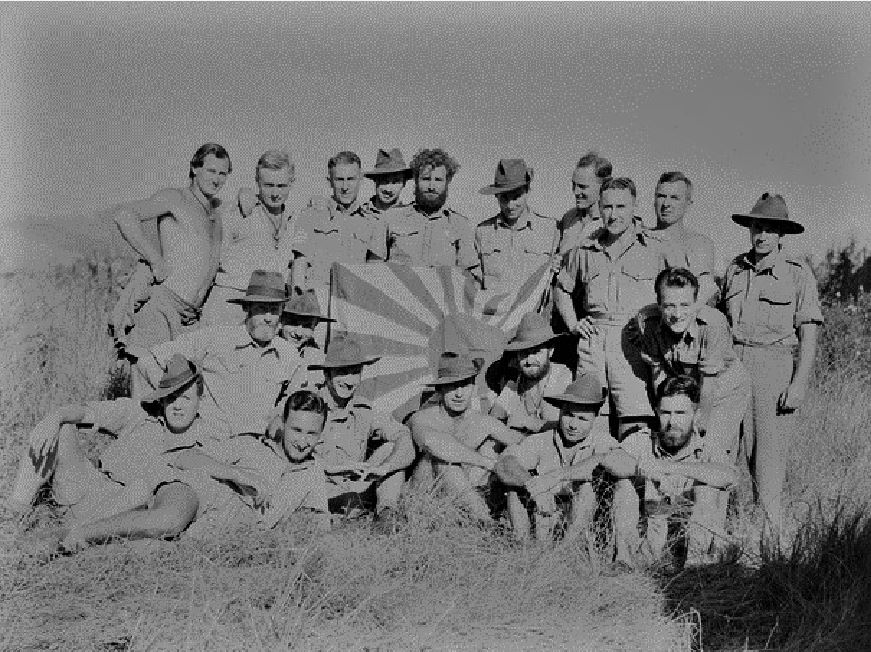Military casualties wounded or killed due to enemy action or disease are part of the warfare’s inevitable cost that has a continuing impact after the war is over. World War II in Papua New Guinea is nearly beyond living memory. Nevertheless, it justifies a brief review of the highly variable mortality figures to remind current military medical personnel of their heritage and the awful consequences of failure during wartime. Tropical diseases took a tremendous toll on both combat and support units in New Guinea; whether infections with malaria or dysentery killed the soldier largely depended on the availability of medical support. Combat in the jungle tended to be brief and violent but only affected groups immediately in contact with the enemy. Military limitations in Papua New Guinea were dominated by extraordinarily difficult terrain and logistical problems beyond anything ever imagined before the War. All available resources were mobilised, often by conscription from various local ethnic groups who largely had little, if any, political affiliation with the conflict. Death was the cost of failure, sometimes due to tactical mistakes but more often simply the adverse consequence of handling lethal weapons over great distances in an unforgiving environment.
An initial word about comparing military casualty statistics is appropriate. Although mortality is a hard endpoint that is usually accurately recorded in military units, this is not always true in paramilitary units such as the large labour forces mobilised by the Australian and New Guinea Administrative Unit (ANGAU) during World War II. Records for units destroyed during the invasion of Rabaul in January 1942, as well as those during the Kokoda Campaign, were at best fragmentary.1,2 There is no intention to imply that some unit’s sacrifice was less in quality because its casualties were lower in quantity. Different units had different functions, and combat casualties in support units were obviously lower than in front-line infantry or those designated for guard or reconnaissance duties. In the Pacific region, the Australian Army’s official statistics list 6294 killed in action (KIA), 1090 who died of wounds (DOW), or about 8000 all-cause deaths occurring in the Pacific, with an overall estimated 2–3% dead.3 This does not count prisoner of war (POW) deaths. A baseline casualty value for the Pacific War is suggested by one Indigenous infantry unit that did not actually serve in Papua but did have a limited combat role in Dutch New Guinea. The Torres Straight Light Infantry Battalion had 13 wartime deaths (one in combat) or 1.5% mortality, which likely indicates a minimum value for wartime military service during World War II.4
There were three major forms of military-type service for Papuan or New Guinean people during World War II. The Royal Papuan Constabulary (RPC), with 2476 total recruited, was a police force that performed vital service in maintaining civil order as well as searching for downed aircraft and the crews (see Figure 1).5 The Papuan Infantry Battalion (PIB) was initially raised in 1940 and expanded during the War to three battalions by adding New Guinea for a total of 3850 recruited (see Figure 2). Officers were all from the Australian Army, and the PIB’s primary war utilisation was as patrol scouts for other combat units in the Sepik and Bougainville campaigns.6 ANGAU, with 2026 Australian officers, many from the prewar civil administration, recruited tens of thousands of local men initially as load carriers in mountain areas without roads whose function later moved more towards construction and other logistics duties. At the peak in September 1944 more than 35 000 men were involved in ANGAU, and it is difficult to establish a total denominator for wartime service given incomplete records (see Figure 3).7

Figure 1: Members of the Royal Papuan Constabulary march in formation with weapons about 1943. Australian War Memorial photo 016116, now in the public domain.

Figure 2: Members of Papuan Infantry Battalion in the forward area celebrate a successful clash with Japanese soldiers in New Guinea. Australian War Memorial photograph 016085, now in the public domain.
Casualties for the RPC are listed as 28 combat deaths, with 63 other deaths or about 3.7% overall.5 In the PIB (including later added New Guineans), there were 81 combat and 75 other deaths or 4.1% wartime mortality.6 Twenty-four ANGAU Australian officers died from enemy action with two known disease deaths or 1.2% mortality. Numbers are more difficult for the ANGAU labourers who were scattered far and wide; however, it is known that 46 died from enemy action, and another 91 were wounded despite their supposed non-combat roles. At least 2024 ANGAU carriers/labourers died during the War, mainly of infectious diseases such as malaria and dysentery, giving an estimated mortality of about 5%. This would have been much higher in those participating in the 1942 Kokoda Campaign.7 A 4–5% mortality rate would seem to be an overall average for Papuans and New Guineans participating directly in World War II.

Figure 3: Papuan carriers from the Australian New Guinea Administrative Unit (ANGAU) moving supplies across the Brown River in the Owen Stanley Range in November 1942. Australian War Memorial photo 027050, now in the public domain.

Figure 4: Members of B Company, New Guinea Volunteer Rifles display a Japanese flag they captured on 21 July 1942 at Mubo, part of the Salamaua–Lae campaign. Australian War Memorial photo 013147, now in the public domain
Higher casualty rates were seen in Australian infantry units directly fighting the Japanese. The 39th Infantry Battalion was an Australian militia unit that took the brunt of the early fighting during the Kokoda Campaign. The 39th BN recorded 118 KIA, 13 DOW and five disease deaths for a total of 8.2% dead and another 266 wounded in action (WIA). Attrition due to disease and exhaustion was also exceptionally high. Following 6 months in combat during the Kokoda Campaign, it was reported that only seven officers and 25 other ranks remained (2%) on duty of those originally deployed. The New Guinea Volunteer Rifles (NGVR) was raised as mainly white, but with a few Chinese as well, local militia in New Guinea from 1939. There were 95 deaths recorded in the NGVR before it was disbanded in 1943, most of which occurred in the fall of Rabaul or the sinking of the Montevideo Maru with POWs aboard.8 The 12% mortality estimate should not be relied on heavily due to loss of records and movement into other units such as ANGAU. One of the worst instances of an Australian Army unit being essentially eliminated entirely occurred with the 2/22nd Battalion AIF, which was garrisoning Rabaul as part of ‘Lark Force’ when the Japanese South Seas Detachment arrived in January 1942. At least 603 22 Battalion members died either on New Britain or in the sinking of the Montevideo Maru; roughly three-quarters of the unit perished, with only a remnant escaping across the mountains and then by boat to Papua.2
It is useful to compare some non-Australian units also fighting in New Guinea. The US Army 32nd Infantry Division carried a heavy combat burden during the Papuan Campaign around Buna-Gona. The 32nd Division suffered 2520 battle casualties, of which 586 KIA and another 100 died of disease or other causes for about 7% mortality.9 Perhaps more significant in terms of resources were the 7125 non-battle casualties, of which 2952 required hospitalisation (41%), largely from malaria and dysentery. The total casualty count of 9956 exceeded the division’s entire battle strength due to replacements received. The Japanese military fared even worse than the Allies. The South Seas Detachment consisted of marine infantry and led the invasion of Rabaul, the pursuit of the 22nd Battalion across New Britain and then the Kokoda Campaign across Papua.2 Nearly the entirety of a component unit consisting of 1 BN/144th Regiment developed malaria, and 5% likely died of the infection while on New Britain.10 Only a quarter of the South Seas Detachment survived the retreat from Kokoda back to Lae. Based on the 11 500 surrendered Japanese personnel that repatriated from Muschu Island at the War’s end in 1946, it appears that 79% of the Japanese soldiers who landed in Papua New Guinea did not survive the War.11 Uncertainty exists in the total numbers deployed and due to the mixing of units, but the casualty rate was clearly catastrophic. Most deaths were not in combat but resulted from disease and starvation after they were cut off from food supplies and medical support. In 1943, General Douglas MacArthur said, ‘The jungle will finish them for us’, and he was correct in his assessment.
How should we think about the wide range of unit casualties in Papua New Guinea during World War II? Some units restricted to local duties with little contact with the enemy did relatively well; however, being a conscripted Papuan load carrier was still risky, especially when the villagers remaining at home had to manage without most of their able-bodied men, taken by ANGAU.7 In the infantry battalions, some units were sacrificed by military necessity to hold the line against the Japanese offensive—only barely, as it turned out in Kokoda or failing, as in Rabaul. Extreme casualties occurred when defeat or capture caused unit disintegration, as no military force can function long in the jungle without supplies and medical support. Graphic accounts of military collapse reflect that one cannot expect garrisons to survive cut off on a tropical island. We need to ensure that the Australian Defence Force of the future is never presented with such impossible situations as faced by the Rabaul garrison with a clear appreciation of what is or is not possible when armed conflict occurs. Close collaboration with all our allied forces needs to be a priority for the ADF of the future as well as in its historical past.
Corresponding Author: G D Shanks, Dennis.Shanks@defence.gov.au
Authors: G D Shanks1,2
Author Affiliations:
1 ADF Malaria and Infectious Disease Institute
2 University of Queensland – School of Public Health Herston






